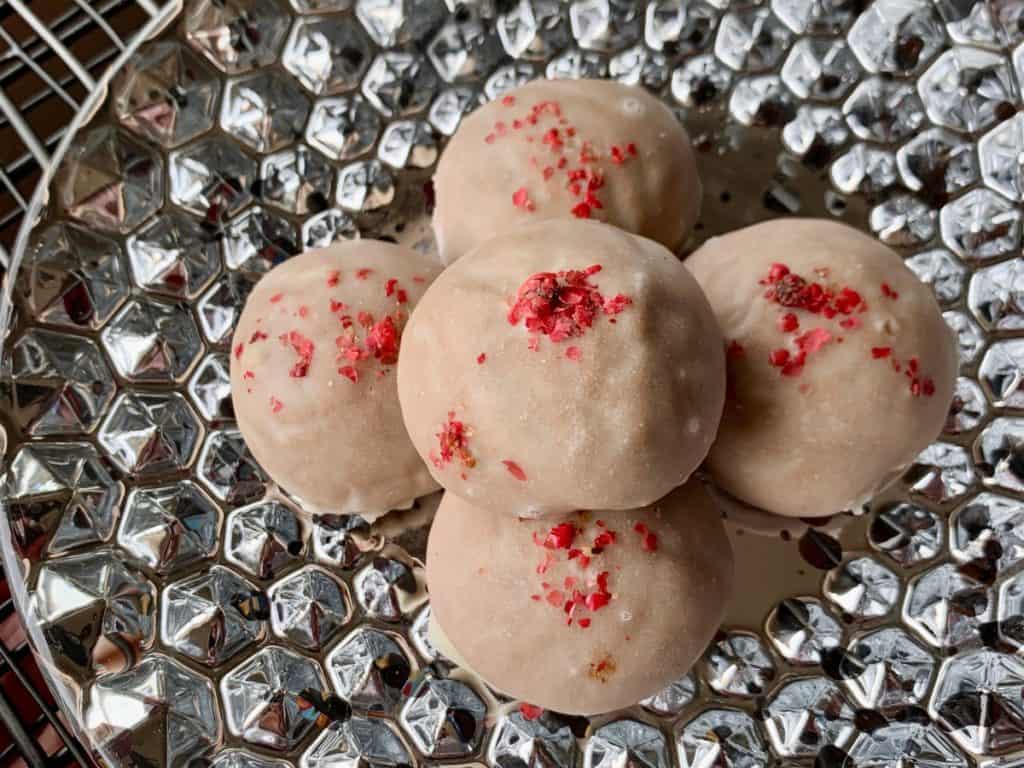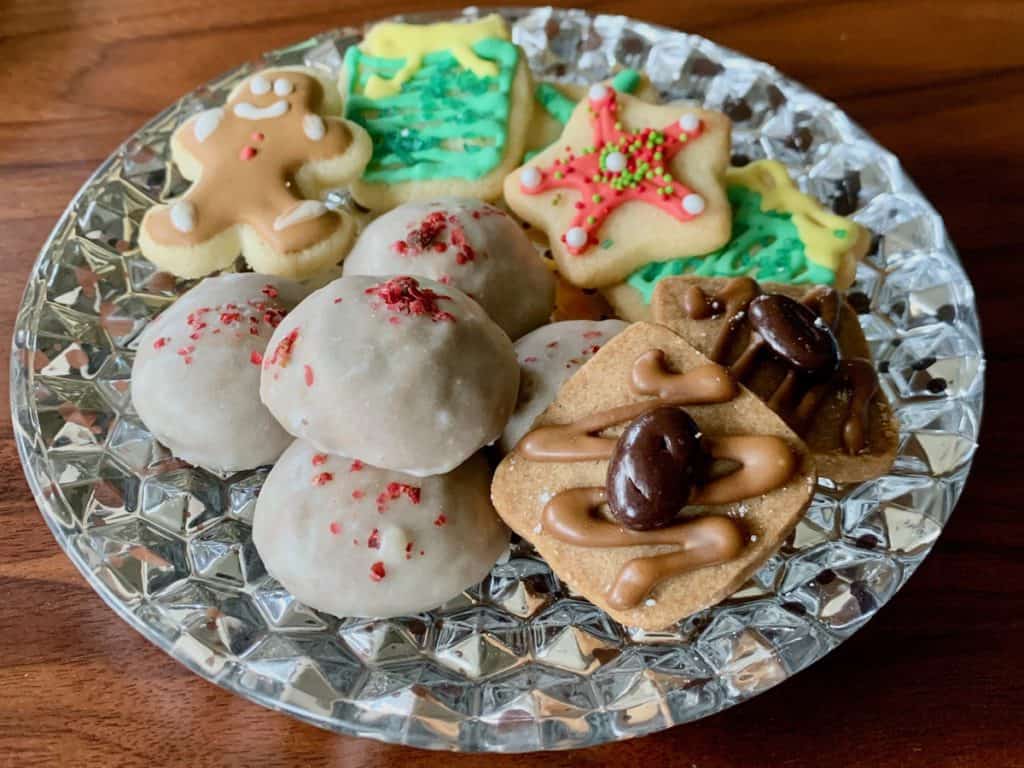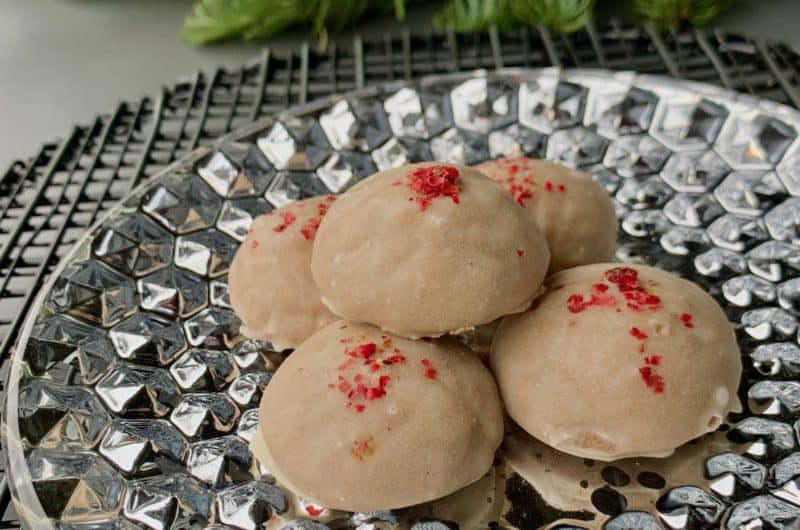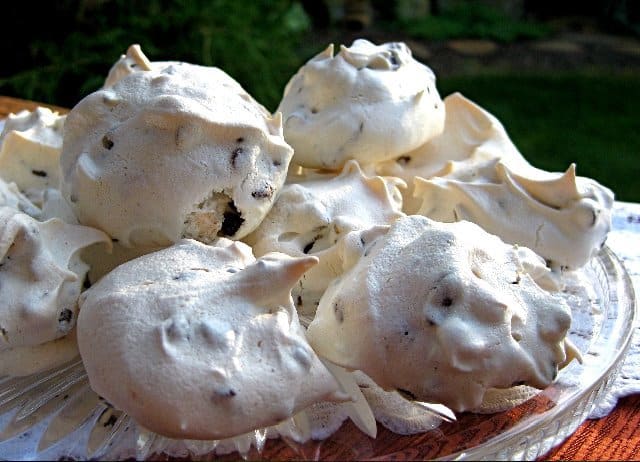The flavor of this little cookie is bold but balanced. A thin sugar glaze provides the perfect contrast of sweetness while a pinch of pink peppercorns adds a lovely festive flourish. They are pretty on a cookie platter and also perfect served as a single sweet on the saucer beside a cup of good coffee.

Confirming Expectations
I can’t say I am surprised at the results I received from 23 and Me. After sending in my kit and waiting expectantly, the report merely confirmed that 94.2% of my ancestry is German. There is nothing even remotely unexpected there, let alone stirring. While the details are somewhat reassuring they fail to inspire. They also offer no explanation as to why I, a close descendant of not only Germans, but Germans who like to bake, have no family recipe for traditional German Christmas cookies.
In my family’s Christmas lore, there is an old farmhouse. It is set beside a rural lane in western Kentucky. It is the home of my grandparents on my father’s side. My grandfather, the son of a German immigrant moved there with my grandmother, who was born in Germany, in the late 1800’s. Together they brought up six children on that farm.
Grandma’s mother spoke only German even after many years in the US. I once asked Aunt Hen if she knew any German. She told me she had to speak it as a child because Großmom, her grandmother, spoke no English. Even so, Aunt Hen quickly forgot all but a few clever sayings in German when Großmom passed away. To hear her tell it years later, she was indifferent to shedding the German language. She had no further use for it.
Family Foodways
After Grosßmom died, Grandma likely continued in some of the German ways. Then Grandma died. With her passing the traditions became scattered and faded. They were mostly memories by the time I came along. I heard stories of Christmases with Grandma, of the whole family gathering at the old house on Christmas Eve. The family shared fond recollections of cedar trees cut from the back field and adorned in the parlor. Smiling they recalled Grandma and Aunt Hen making forty pounds of candy at Christmastime: creamy candies, fondants, three colored squares with a nut half on top, fudge and nut rolls.
Even in their reverie I can’t remember hearing anything about traditional German cookies. When pressed, Aunt Hen and Aunt Bet remembered Springerle and maybe Pfeffernüsse somewhat vaguely. With a thoughtful nod they confirmed they had eaten them as children. “Maybe they were brought by a relative,” they offered. “We didn’t like them much. Too dry or hard,” they said. Having no further interest in those old-fashioned Christmas cookies, Aunt Hen moved on to other recipes.
Despite her disinterest in specific German traditions, Aunt Hen loved to bake at Christmas. Every year she made batch after batch of Christmas cookies. She continued to make holiday fudge, as in years past, but when we baked she focused on chewy bar cookies from recipes she found in current cookbooks and magazines. I liked shaped cookies and more modern styles with simple flavors and lots of decorating. Between us we didn’t spend much time looking back or searching out traditional German recipes.

A Newly Authentic Pfeffernüsse
Over the years I’ve tried a few versions of Pfeffernüsse. I even posted a recipe several years ago for a cute little version of Peppernuts that sparkle with sugar sprinkles. They are delightful but don’t seem quite traditional to me. Maybe it’s just that they are relatively easy to prepare and disappear too quickly.
I’ve also tasted the sugar crusted type of Pfeffernüsse several times. I’m pretty sure they were always store bought. None inspired me to eat another. While the sugary white exterior looked inviting, the cookies I tried were always off in texture and overly modest or indifferent in flavor. Though my interest in family history and traditional foodways grew, the charm of German Christmas cookies remained elusive.
Then, last year I spotted this recipe in the food pages of The Oregonian, our local newspaper. There it is attributed to Martha Stewart’s Cookie Perfection cookbook. These cookies are shaped like my understanding of traditional Pfeffernüsse, in small rounded mounds. After baking, they are dipped in a sugar glaze that coats the cookie in a smooth white shell, reminiscent of a tiny snowball. This thin glaze provides the perfect contrast of sweetness to the bold spiciness of the cookies themselves. Finally, each cookie is topped with a pinch of beautiful cracked pink peppercorns to add a festive flourish. After a quick scan of the recipe I knew I had to try it.
My Pfeffernüsse turned out great. They were, perhaps, my favorite Christmas cookie last year. This year I am loving them all over again. Each nugget is bold but balanced; dramatically expressive, yet elegantly composed. They are pretty on a cookie platter and also perfect served as a single sweet on the saucer beside a cup of good coffee.
Pfeffernüsse
Course: DessertCuisine: GermanDifficulty: Moderate60
cookies25
minutes30
minutes30
MinutesThe flavor of this little cookie is bold but balanced. A thin sugar glaze provides the perfect contrast of sweetness while a pinch of pink peppercorns adds a lovely festive flourish. They are pretty on a cookie platter and also perfect served as a single sweet on the saucer beside a cup of good coffee.
Ingredients
- Cookies:
2-1/4 cups (11 ounces) flour
1/4 teaspoon baking soda
3/4 teaspoon ground cinnamon
1/2 teaspoon ground allspice
1/4 teaspoon ground cloves
1/4 teaspoon freshly grated nutmeg
1/4 teaspoon freshly ground black pepper
1/2 cup butter, at room temperature
3/4 cup packed brown sugar
1/4 cup molasses
1 egg
1/2 teaspoon vanilla
- Glaze:
3-1/2 cups confectioners’ sugar, sifted
1/3 cup whole milk
1/4 teaspoon kirsch (optional)
- Garnish:
Coarsely ground pink peppercorns
Directions
- Cookies:
- Preheat oven to 350 degrees.
- In a medium bowl, whisk together flour, baking soda, and spices. In the large bowl of an electric mixer, beat butter, brown sugar and molasses on medium speed until fluffy, about 3 minutes. Scrape down mixing bowl. Beat in egg and vanilla until combined. Gradually add flour mixture, mixing on low until just combined.
- Using a small (1¼-inch) cookie scoop (or a rounded teaspoon) scoop dough into balls. Roll lightly between damp hands to smooth and place 1” to 1-1/2” inches apart on a parchment-lined baking sheet. (Cookie dough can be frozen at this point for later use.)
- Bake cookies at 350 degrees, rotating baking sheets halfway through. The cookies are done when golden, firm to the touch and cracking slightly, about 15 minutes. Transfer cookies on baking sheets to wire racks. Cool completely.
- Glaze:
- In a medium bowl, whisk together confectioners’ sugar, milk, and kirsch, if desired. Using a fork, dip each cookie into the glaze to coat. Tap lightly to remove excess glaze. Place on a wire rack. Sprinkle the top of the cookie with a pinch of coarsely ground pink peppercorns. Set cookies aside to dry. Repeat with remaining cookies.
- When the glaze is almost dry, carefully lift each cookie from the rack dragging the bottom against the rack to remove excess drips. Then transfer the cookie to a piece of parchment or waxed paper to dry completely.
- When dry, store cookies in an airtight container.
Notes
- Recipe Source: a newspaper article in The Oregonian that attributes the recipe to Martha Stewart’s Cookie Perfection cookbook.
- If you are short of time or lack interest in glazing your cookies, coat them with powdered sugar instead. After removing your cookies from the oven, place the baking sheet on a wire rack and allow to cool for 10 minutes. Meanwhile place 1-1/2 cups of powdered sugar in a lunch sized brown paper bag. After 10 minutes, while cookies are still warm, place several cookies in the bag. Fold the top down and shake the cookies until fully coated in powdered sugar. Place sugared cookies on a wire rack to cool completely and continue with the next batch until all cookies are coated.







